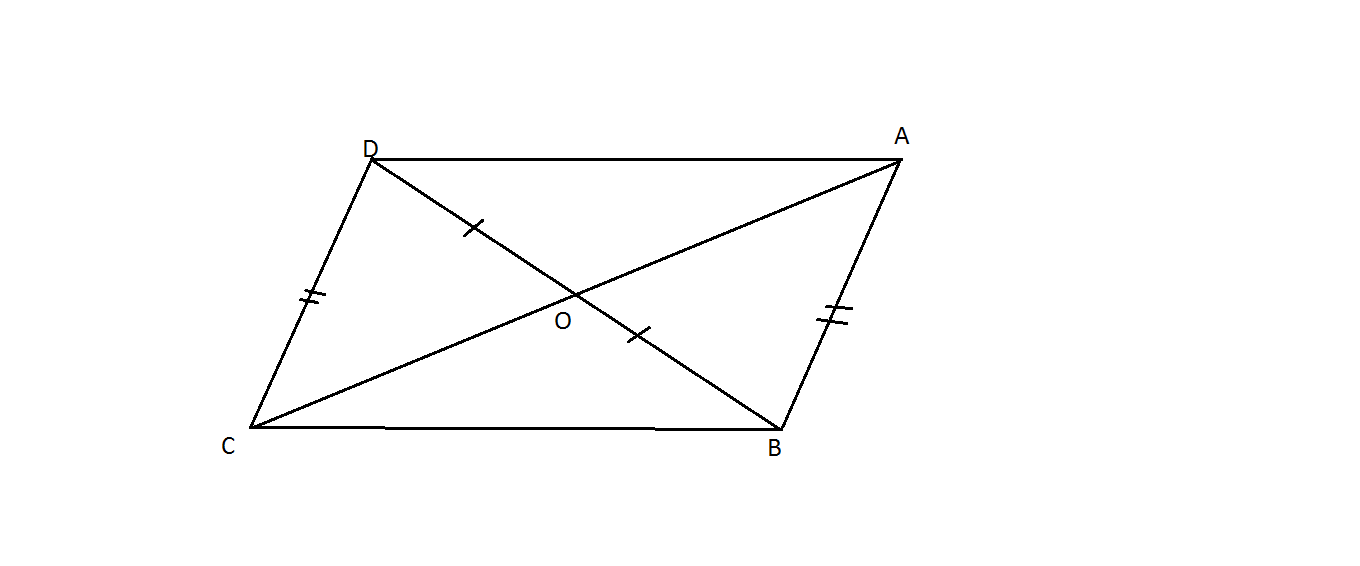PLEASE HELP!!!!!!!!!!!!!!!!! Is my proof correct ......
Q) Diagonals AC and BD of quadrilateral ABCD intersects at O . If AB=CD , then show that 1) ar(DOC) = ar(AOB) 2) ar (DCB) = ar(ACB) [ question from NCERT class 9 textbook.

In triangle ABD , AO is the median therefore ar(AOB) = ar(AOD) [ since median of a triangle divides it into 2 triangles with equal areas ]...................................(1) and also in triangle BCD , CO is the median and ar(COB) = ar ( COD) ...................................(2) . Adding (1) and (2) we get ar(ABD)= ar(BCD) . Thus diagonal divides it into 2 congruent triangles. Now we consider equal lines AB and CD after joining their end points we would either get an isosceles trapezium if the lines are not parallel or a parallelogram if the lines are parallel . But the diagonal of a isos. trapezium does not divide it into 2 triangles with equal areas , therefore it must be a parallelogram . Now triangles ACB and BCD are on the same base BC and between same parallels AD and BC . therefore ar(DCB)=ar(ACB) [ proof 2] and subtracting ar(BOC) from both sides we get ar(DOC)=ar(AOB] [ proof 1 ] . Hence proved . [ The question can easily be done by drawing perpendiculars from B and D on AC.]
Easy Math Editor
This discussion board is a place to discuss our Daily Challenges and the math and science related to those challenges. Explanations are more than just a solution — they should explain the steps and thinking strategies that you used to obtain the solution. Comments should further the discussion of math and science.
When posting on Brilliant:
*italics*or_italics_**bold**or__bold__paragraph 1
paragraph 2
[example link](https://brilliant.org)> This is a quote# I indented these lines # 4 spaces, and now they show # up as a code block. print "hello world"\(...\)or\[...\]to ensure proper formatting.2 \times 32^{34}a_{i-1}\frac{2}{3}\sqrt{2}\sum_{i=1}^3\sin \theta\boxed{123}Comments
[Adding (1) and (2) we get ar(ABD)= ar(BCD) ].................................... this part of your answer goes wrong because this part can be only be prooved if bo would be the median if BO would be the median than TRIANGLE BOC AND BOA would have equal area. and then ar[cob]=ar[boa]. Then area of all the four triangles would be equal. then you can prove your first part. so, this prove is wrong.
Log in to reply
But , I have not used BO . I have just used median AO and CO .
Log in to reply
but by using ao and co u can not prove ar[abd] =ar [dcb]. i think you are not clear with my answer let me explain . let us take ar[abd]=x and ar[cbd]=y then since ao is the median of x ar [aod]=ar[aob]=1/2x. since co is the median ar[cod]=ar[cob]=1/2y. and 1/2y would be only equal to 1/2x if their areas are equal that is do would be the median.i hope your doubt would be clear by this for more doubt about this contact me at 0788(2290223).
Log in to reply
@karandeep singh ludhar @abhishek anand .. Kaddu's way is correct.. I did it the same way. This question appeared in our exams too right?.. Kaddu apna e-mail id de
Log in to reply
But the question appeared in our exams just one time and also not right but in paper .
Log in to reply
Bhai english -_- .. Aur Kaddu Topper !!! IMO ka solve kr liya re :'( .. Rukk be dharta hoon tereko
Log in to reply
Tereko ke baad bracket kon lagayega .
Log in to reply
Bracket konchika :p :p .. Tu aara hai FIITJEE?
Log in to reply
Why is a tomato red and round . bataa.
Log in to reply
Bhai tu hi bta dey... Because Brinjal is long and purple :p _/_
Log in to reply
Because if it would have been green and long it would be a cucumber . <english me isliye likha kyon ki question aur answer dono english me the .
Log in to reply
tu apna number de na
Log in to reply
Par maine kal hi to tujhe diya tha .
Log in to reply
vapas se dede mere bhai
Kaddu ka 8959868806 hai.. I remember
Log in to reply
The number is not correct .Haaaaaaaa
Log in to reply
Bhai change ho gaya hoga.. Give me your new number and email id
karan apne nani ke ghar gaya hai vaha ka number mang raha hoo
Ye question try karo.. Its a level 4 question by me : https://brilliant.org/problems/heart-attack-omg-p/?group=rb5lqcXVsIsB#!/solution-comments/89095/
Stud ^^ _/_
hybrid brinjal khata hai kya
kaise sahi hai bhai /////explain??????????
Log in to reply
Kaise galat hai /////explain??????????
Search for NCERT Model Solutions :)
Log in to reply
apna phone number de karta hoo explain\
solution me perpendicular bana ke kiye hai
sir, tera answer sahi kiye kya
Log in to reply
Hao.. Mere 2marks kate construction mei :'(
Log in to reply
tu to median se kiya hai jo quetion me diya hua tha to tu construction kya kiya
Log in to reply
DB pe perpendiculars draw karke (From A and C) dono ko congruent proove krde.. Easy and simple =D.. Ye shayad question 17 thaa na?
Log in to reply
vahi to mai bhi kiya hoo lekin kara ka prove galat hai